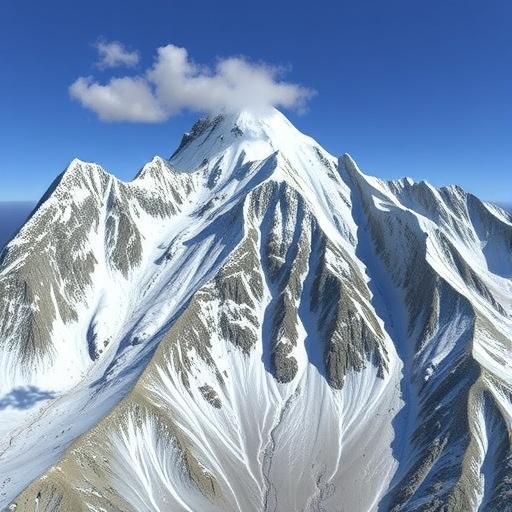In a groundbreaking study set to reshape our understanding of geological formations, researchers led by Guo, Wang, and Zuo have made remarkable advancements in the field of geology by utilizing cutting-edge technology to map the vast expanses of Himalayan leucogranite. The research harnesses the power of multi-source remote-sensing data coupled with sophisticated U-Net convolutional networks to create a highly detailed representation of these unique rock structures. This study is not just a result of academic inquiry; it holds significant implications for resource exploration, environmental monitoring, and understanding the geological evolution of one of the world’s most majestic mountain ranges.
Himalayan leucogranites are significant geological features, predominantly composed of quartz, feldspar, and biotite. Their formation is often associated with the intense metamorphic processes that these mountain ranges have undergone over millions of years. By shedding light on the distribution and characteristics of leucogranitic bodies within the Himalayas, this study offers crucial insights that could benefit various scientific fields, including geochemistry, tectonics, and climate science.
Utilizing multi-source remote-sensing data illustrates a remarkable shift in how geological studies are approached. Traditional methods, often reliant on field surveys and limited aerial imagery, can be labor-intensive and time-consuming. However, the incorporation of satellite imagery and aerial data enhances the breadth and accuracy of geological mapping. In particular, this research employs data from various sensors and platforms, allowing for a more comprehensive analysis of the geological landscape.
The U-Net convolutional network serves as the brain behind the mapping process. Originally developed for biomedical image segmentation, U-Net’s adaptability makes it equally effective in geological applications. This deep learning architecture facilitates the detection and segmentation of various rock types, enabling researchers to create precise maps that detail not just the locations of leucogranite bodies, but also their sizes and geological contexts. The ability of U-Net to learn and improve through massive datasets is pivotal, ensuring that the mapping is both dynamic and accurate.
One of the paramount challenges in geological studies is accurately interpreting the data derived from remote sensing. The findings from Guo, Wang, and Zuo highlight how machine learning techniques can assist in overcoming these obstacles. For instance, differentiating between similar rock types has traditionally presented a hurdle for geologists. By leveraging U-Net’s capabilities, the researchers can significantly reduce errors and refine their classifications—a substantial improvement that marks a significant advantage over conventional methods.
Beyond methodological advancements, the findings of this research are expected to generate considerable interest within the sphere of natural resource exploration. The mapping of leucogranite bodies can directly influence mining operations, as these geological formations often control the spatial distribution of valuable deposits. Thus, accurately identifying these formations may lead to more strategic resource extraction, thereby enhancing the economic viability of mining ventures in the region.
The implications of this mapping extend into environmental monitoring as well. Understanding the characteristics and locations of leucogranites can provide essential data for assessing the impacts of climate change and human activities on the Himalayan ecosystem. With the rising influence of climate change, it becomes increasingly crucial to monitor geological features that may be vulnerable to environmental shifts, like glacial melting and landslides.
Furthermore, this study is a testament to the collaborative nature of modern scientific endeavors. It showcases an integrative approach that combines geology, computer science, and remote sensing technologies. In an age where interdisciplinary approaches are becoming more prevalent, this research serves as a blueprint for future studies. By establishing connections between different fields, researchers can address complex issues that require multifaceted solutions.
The Himalayan region is not only a geological wonder but also a cultural and ecological treasure trove. The outcomes of this research could inform conservation strategies that promote the sustainability of the Himalayan environment. By providing detailed geological maps, stakeholders can make informed decisions regarding land use and conservation efforts that uphold the integrity of this fragile ecosystem.
The next stages of this research may involve applying the developed techniques to other mountainous regions, both in Asia and globally. The adaptability of U-Net and the multi-source approach could revolutionize geological mapping in places where traditional methodologies fall short. As the demand for accurate geological data rises, expanding this technique to other areas could enhance our understanding of global geology.
In summary, Guo, Wang, and Zuo’s study is poised to ignite discussions across various scientific communities, pushing the boundaries of what is possible in geological mapping. This research exemplifies the capabilities of advanced technology in understanding the complexities of our planet’s geological makeup, ultimately contributing to more sustainable practices and informed decision-making processes that cater to both scientific and public interests.
The ramifications of this research are far-reaching, impacting academia, industry, and environmental policy alike. The convergence of remote sensing, machine learning, and geological inquiry fosters the potential for new discoveries that could yield considerable insights into Earth’s processes, its resources, and the interplay with climate change. As this study solidifies its place in geological literature, it sets a precedent for future explorations that intertwine technology with the intricate tapestry of our planet’s geology.
Moving forward, the integration of these advanced technologies in geological studies will undoubtedly lead to more robust methodologies that redefine our approach to understanding complex geological systems. The journey of this remarkable mapping endeavor is just beginning, and the scientific community watches with keen anticipation for the potential revelations that lie ahead.
Subject of Research: Large-scale Himalayan leucogranite mapping using remote sensing and U-Net convolutional networks.
Article Title: Large-scale Himalayan Leucogranite Mapping Based on Multi-source Remote-Sensing Data and U-Net Convolutional Network.
Article References: Guo, D., Wang, Z. & Zuo, R. Large-scale Himalayan Leucogranite Mapping Based on Multi-source Remote-Sensing Data and U-Net Convolutional Network. Nat Resour Res 34, 2403–2421 (2025). https://doi.org/10.1007/s11053-025-10526-6
Image Credits: AI Generated
DOI: https://doi.org/10.1007/s11053-025-10526-6
Keywords: Himalayan leucogranite, remote sensing, U-Net convolutional networks, geological mapping, machine learning, environmental monitoring, resource extraction.




